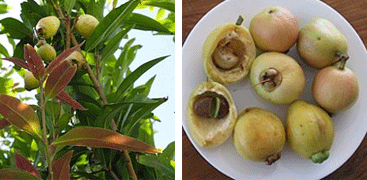
The rose apple tree a shrub but is generally a tree reaching 25 or even 40 ft (7.5-12 m) in height, and has a dense crown of slender, wide-spreading branches, often the overall width exceeding the height. The evergreen leaves are opposite, lanceolate or narrow-elliptic, tapering to a point; 4 to 9 in (10-22 cm) long, and from 1 to 2 1/2 in (2.5-6.25 cm) wide; somewhat leathery, glossy, dark-green when mature, rosy when young. The flowers are creamy-white or greenish-white, 2 to 4 in (5-10 cm) wide, consisting mostly of about 300 conspicuous stamens to 1 1/2 in (4 cm) long, a 4-lobed calyx, and 4 greenish-white, concave petals. There are usually 4 or 5 flowers together in terminal clusters. Capped with the prominent, green, tough calyx, the fruit is nearly round, oval, or slightly pear-shaped, 1 1/2 to 2 in (4-5 cm) long, with smooth, thin, pale-yellow or whitish skin, sometimes pink-blushed, covering a crisp, mealy, dry to juicy layer of yellowish flesh, sweet and resembling the scent of a rose in flavor. In the hollow center, there are 1 to 4 brown, rough-coated, medium-hard, more or less rounded seeds, 3/8 to 5/8 in (1-1.6 cm) thick, which loosen from the inner wall and rattle when the fruit is shaken. Fragments of the seedcoat may be found in the cavity.
Origin and Distribution
The rose apple is native to the East Indies and Malaya. It was introduced into Jamaica in 1762. In Guatemala, the tree may be planted as a living fencepost or in hedgerows around coffee plantations. For this purpose, it is drastically pruned to promote dense growth.
Climate:
The rose apple flourishes in the tropical and semi tropical climates only. In India, it ranges up to 4,400 ft (1,350 m). It does best on the banks of canals and streams and yet tolerates semi-arid conditions. Prolonged dry spells, however, are detrimental.
Soil: A deep, red loamy soil is considered ideal for the rose apple.
Propagation: Most rose apple trees are grown from seeds, which are polyembryonic (producing 1 to 3 sprouts), but the seedlings are not uniform in character nor behavior. In India, vegetative propagation has been undertaken with a view to standardizing the crop and also to select and perpetuate dwarf types. Using cuttings, it was found that hardwood does not root even with chemical growth promoters. Treated semihard wood gave 20% success. Air-layers taken in the spring and treated with 1,000 ppm NAA gave 60% success. Air-layers did not root in the rainy season. In budding experiments, neither chip nor “T” buds would take. Veneer grafting in July of spring-flush scions on 1-year-old rootstocks was satisfactory in 31% of the plants. Fruiting can be expected within 4 years.
Planting:
Prior to planting, the field is properly cleared and ploughed. Pits of 1 x 1 x 1 m size are dug at the distance of 5 to 6 m both ways. Usually, work of digging of pits is completed before the onset of monsoon. The pit are filled with mixture of 75% top soil and 25% well rotten farmyard manure or compost.
Spacing: 1. 5×5 mt
2. 6x 5mt
3. 10 x10mt
Fertilizer Application
The rose apple trees are generally not manured. This is not because they do not require manuring or fail to respond to it but because they can stand a good deal of neglect. An annual dose of about 20 kg FYM during the pre-beating period and 50 kg per tree bearing trees is considered.
Normally, seedling rose apple trees start bearing at the age of 5 to 6 years while grafted or budded trees come into bearing in 4 to 5 years. On very rich soils, the trees have a tendency to put on more vegetative growth with the result that fruiting is delayed. When the trees show such a tendency, they should not be supplied with any manure and fertilizer and irrigation should be given sparingly and withheld in September-October and again in February-March.
This helps in fruit bud formation, blossoming and in fruit setting. Sometimes this may not prove effective and even more drastic treatments such as ringing and root pruning may have to be resorted to.. A fruit grower has, therefore, to be cautious in manuring and fertilizing rose apple trees and hence, has to adjust the doses according to the growth and fruiting of trees.
| 4-5 years old plantation | |
| FYM | 50 kg per plant /year |
| Nitrogen | 500 gm per plant/year |
| Phosphorus | 200 gm per plant/year |
| Postash | 200 gm per plant/year |
Irrigation
In early stages, the roseapple tree requires frequent irrigations but after the trees gets established, the interval between irrigations can be greatly decreased. Young trees require 8 to 10 irrigations in a year. The mature trees require only about half the number, which should be applied during May and June when the fruit is ripening. During autumn and winter months, just an occasional irrigation may be applied when the soil is dry. This will also save the trees from the ill effects of frost in winter.
Training and Pruning
Regular pruning in rose apple is not required. However, in later years the dry twigs and crossed branches are removed. While training the plants, the framework of branches is allowed to develop above 60 to 100 cm from the ground level.
The average yield of fruits from a full grown seedling tree is about 3-5 kg and from a grafted one 6-8 kg per year.